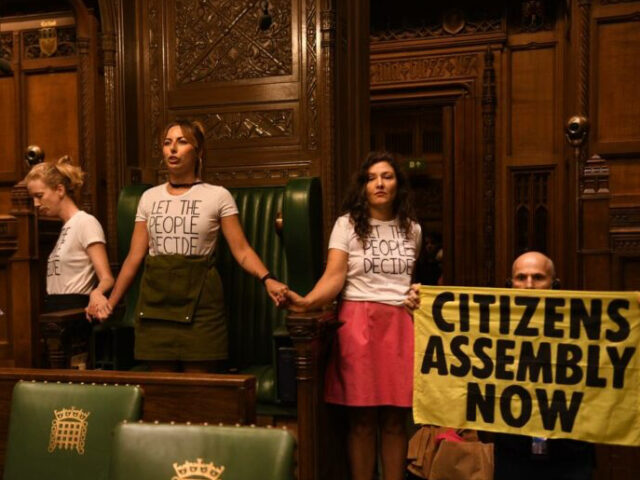Members of the eco-warrior Extinction Rebellion activist collective broke into the House of Commons on Friday and superglued themselves to the chair of the Speaker to protest the alleged climate “crisis”.
Carrying banners calling for a “citizens’ assembly” — one of the chief demands of the leftist group, being the creation of a mob-rule institution to push forward their radical green agenda — so-called “supporters” of Extinction Rebellion infiltrated the Commons Chamber and claimed to have superglued themselves “around” the Speakers Chair at the head of the room.
“We are in crisis. And what goes on in this chamber every day makes a joke out of us all. We can not afford to carry on like this,” the group of protesters said without irony, given that the Prime Minsiter Boris Johnson’s green agenda enacted in that very room has been blamed for the ongoing energy crisis that is impoverishing millions of Britons.
Although police and security apparently failed to prevent the potentially destructive protest, London’s Metropolitan Police Service issued the statement: “The Met is aware of a demonstration by a number [of] protesters at the Palace of Westminster. Met police and Parliamentary staff are responding.”
BREAKING NEWS: Extinction Rebellion supporters have superglued around the Speakers Chair inside the commons chamber.
Right now inside Parliament a speech is being read out demanding a Citizens' Assembly Now: “We are in crisis. We can not afford to carry on like this…" pic.twitter.com/JqKBasRaCH
— Extinction Rebellion UK 🌍 (@XRebellionUK) September 2, 2022
The Speaker’s Chair, which sits at the head of the Commons Chamber and is inhabited by the Speaker of the House, currently Sir Lindsay Hoyle, was donated to the Parliament by the British Commonwealth nation of Australia after the House of Commons was bombed to destruction in 1941 during the Second World War.
The previous chair was designed by English architect Augustus Welby Pugin around 1849 after he was tasked to redesign the interior of the Palace of Westminster after the previous building was destroyed in the fire of 1834.
On the back of the Speaker’s Chair sits the bag in which Members of Parliament submit petitions to the House from the public.

3rd November 1941: A bomb-damaged section of the House of Commons, London. (Photo by Davis/PNA Rota/Getty Images)
![Mr. Churchill contemplates the ruins of the House of Commons, bombed in May 1941', 1941 (1955). Incendiary bombs which fell on the nights of 10 and 11 May 1941 caused the greatest damage to the Palace of Westminster and the Commons Chamber was entirely destroyed by fire. The Palace was damaged by air raids on fourteen different occasions during the war. From Churchill: The Man of the Century - A Pictorial Biography, edited by Neil Ferrier. [L.T.A. Robinson Limited, London, 1955]. Artist Unknown(Photo by The Print Collector/Getty Images)](https://media.breitbart.com/media/2022/09/GettyImages-615473890.jpg)
Mr. Churchill contemplates the ruins of the House of Commons, bombed in May 1941′, 1941 (1955). Incendiary bombs which fell on the nights of 10 and 11 May 1941 caused the greatest damage to the Palace of Westminster and the Commons Chamber was entirely destroyed by fire. The Palace was damaged by air raids on fourteen different occasions during the war. From Churchill: The Man of the Century – A Pictorial Biography, edited by Neil Ferrier. [L.T.A. Robinson Limited, London, 1955]. Artist Unknown(Photo by The Print Collector/Getty Images)
Activists from Extinction Rebellion, as well as from other splinter eco-groups such as Insulate Britain, frequently glue themselves to roads and even highways in order to stymie police attempts to remove them from obstructing traffic.
Since 2019, the green warrior group has cost the taxpayer over £60 million in policing costs, with some 16,000 officers being deployed at various protests.
WATCH as London police struggle to haul overweight Extinction Rebellion protester under arrest
And READ MORE here: https://t.co/3qZe7XBcad pic.twitter.com/WMXUdPGq65
— Breitbart London (@BreitbartLondon) September 4, 2020
Follow Kurt Zindulka on Twitter here @KurtZindulka

COMMENTS
Please let us know if you're having issues with commenting.